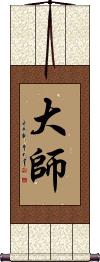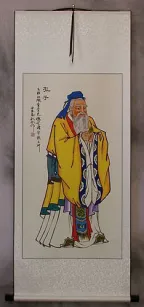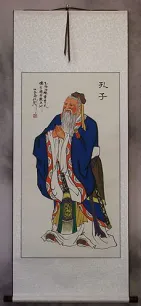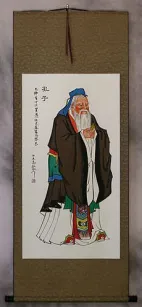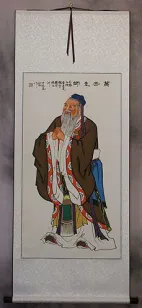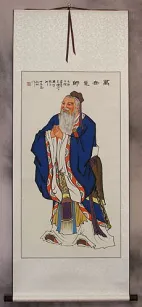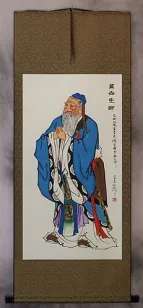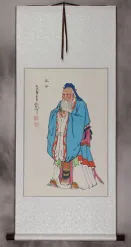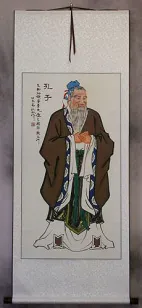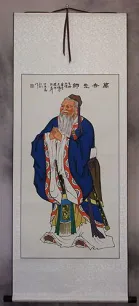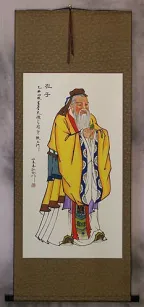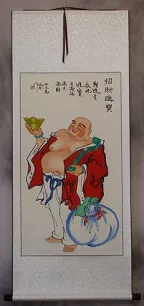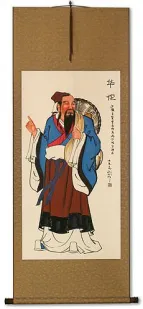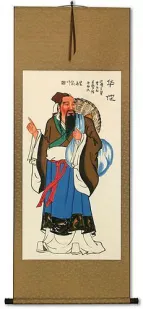Many custom options...
And formats...

Great Bodhisattva in Chinese / Japanese...
Buy a Great Bodhisattva calligraphy wall scroll here!
Personalize your custom “Great Bodhisattva” project by clicking the button next to your favorite “Great Bodhisattva” title below...
Grand Master / Great Teacher
大師 is a way to title a great master, grand master, or great teacher.
This can be used in the context of martial arts or a Buddhist teacher. Thus, it can be used to title a living Buddha, Bodhisattva, or high-ranking monk.
Namu Dai Bosa
The Supreme Mahayana Truth
大乘無上法 means the supreme Mahāyāna truth.
This refers to the ultimate reality in contrast with the temporary and apparent. Other translations include “the reliance on the power of the vow of the bodhisattva” or “the peerless great vehicle teaching.”
Note: This may suggest that Mahayana Buddhism, as practiced in China, Japan, Korea, Vietnam, and other regions is superior (with subtle arrogance) to the original Theravada (or old school) Buddhism. Mahayana and Theravada Buddhists generally get along better than Catholics and Protestants, but there have been schisms.
Light / Bright and Promising Future
光明 is a nice way to say “light” in Chinese and old Korean Hanja.
This is because the word also suggests a bright future or refers to someone who is very promising (great future potential).
The first character means light or bright.
The second character means bright and clear (in this context).
This word appears in most Japanese dictionaries, but it is not the most common Japanese Kanji word for light (more commonly used for the name Mitsuharu).
In old Korean Hanja, this can also mean brightness or brilliance.
In the context of Buddhism, this means “Light emanating from a Buddha or Bodhisattva, symbolizing their wisdom and compassion.”
This in-stock artwork might be what you are looking for, and ships right away...
Gallery Price: $200.00
Your Price: $79.88
Gallery Price: $200.00
Your Price: $79.88
Not the results for Great Bodhisattva that you were looking for?
Below are some entries from our dictionary that may match your Great Bodhisattva search...
| Characters If shown, 2nd row is Simp. Chinese |
Pronunciation Romanization |
Simple Dictionary Definition |
大師 大师 see styles |
dà shī da4 shi1 ta shih daishi だいし |
More info & calligraphy: Grand Master / Great Teacher(honorific or respectful language) {Buddh} great teacher (i.e. a buddha, bodhisattva or high monk, esp. Kobo Daishi); (place-name) Daishi Great teacher, or leader, one of the ten titles of a Buddha. |
菩薩 菩萨 see styles |
pú sà pu2 sa4 p`u sa pu sa bosatsu(p); bosachi(ok) ぼさつ(P); ぼさち(ok) |
More info & calligraphy: Bodhisattva(n,n-suf) (1) {Buddh} bodhisattva; one who has reached enlightenment but vows to save all beings before becoming a buddha; (n,n-suf) (2) High Monk (title bestowed by the imperial court); (n,n-suf) (3) (See 本地垂迹説) title bestowed to Shinto kami in manifestation theory; (surname) Mizoro bodhisattva, cf. 菩提薩埵. While the idea is not foreign to Hīnayāna, its extension of meaning is one of the chief marks of Mahāyāna. 'The Bodhisattva is indeed the characteristic feature of the Mahāyāna.' Keith. According to Mahāyāna the Hinayanists, i.e. the śrāvaka and pratyekabuddha, seek their own salvation, while the bodhisattva's aim is the salvation of others and of all. The earlier intp. of bodhisattva was 大道心衆生 all beings with mind for the truth; later it became 大覺有情 conscious beings of or for the great intelligence, or enlightenment. It is also intp. in terms of leadership, heroism, etc. In general it is a Mahayanist seeking Buddhahood, but seeking it altruistically; whether monk or layman, he seeks enlightenment to enlighten others, and he will sacrifice himself to save others; he is devoid of egoism and devoted to helping others. All conscious beings having the Buddha-nature are natural bodhisattvas, but require to undergo development. The mahāsattva is sufficiently advanced to become a Buddha and enter nirvāṇa, but according to his vow he remains in the realm of incarnation to save all conscious beings. A monk should enter on the arduous course of discipline which leads to Bodhisattvahood and Buddhahood. |
大乘無上法 大乘无上法 see styles |
dà shèng wú shàng fǎ da4 sheng4 wu2 shang4 fa3 ta sheng wu shang fa daijō mujō hō |
More info & calligraphy: The Supreme Mahayana Truth |
劫 see styles |
jié jie2 chieh kou; gou; kou / ko; go; ko こう; ごう; コウ |
to rob; to plunder; to seize by force; to coerce; calamity; abbr. for kalpa 劫波[jie2 bo1] (1) (こう, ごう only) {Buddh} kalpa (eon, aeon); (2) (kana only) {go} (usu. コウ) ko; position that allows for eternal capture and recapture of the same stones 刧 A kalpa, aeon, age; also translit. ka; 'a fabulous period of time, a day of Brahmā or 1, 000 Yugas, a period of four hundred and thirty-two million years of mortals, measuring the duration of the world; (a month of Brahmā is supposed to contain thirty such kalpas; according to the Mahābhārata twelve months of Brahmā constitute his year, and one hundred such years his lifetime; fifty years of Brahmā are supposed to have elapsed... ).' M. W. An aeon of incalculable time, therefore called a 大時節 great time-node. v. 劫波.; The three asaṃkhyeya kalpas, the three countless aeons, the period of a bodhisattva's development; also the past 莊嚴劫, the present 賢劫, and the future 星宿劫 kalpas. There are other groups. 三劫三千佛 The thousand Buddhas in each of the three kalpas. |
下化 see styles |
xià huà xia4 hua4 hsia hua geke |
(下化衆生) Below, to transform all beings, one of the great vows of a bodhisattva. 上求菩提 above, to seek bodhi. Also 下濟衆生. |
僧那 see styles |
sēng nà seng1 na4 seng na sōna |
(僧那僧涅) sannāha (-sannaddha), girding on armour, intp. as a Buddha's or bodhisattva's great Vow. |
光宅 see styles |
guāng zhái guang1 zhai2 kuang chai Kōtaku |
Kuang-chai, name of the temple where 法雲 Fa-yun early in the sixth century wrote his commentary on the Lotus Sutra, which is known as the 光宅疏; 光宅 became his epithet. He made a division of four yāna from the Burning House parable, the goat cart representing the śrāvaka, the deer cart the pratyekabuddha, the ox-cart the Hīnayāna bodhisattva, and the great white ox-cart the Mahāyāna bodhisattva; a division adopted by T'ien-t'ai. |
勢至 势至 see styles |
shì zhì shi4 zhi4 shih chih seiji / seji せいじ |
(personal name) Seiji He whose wisdom and power reach everywhere, Mahāsthāmaprāpta, i.e. 大勢至 q.v. Great power arrived (at maturity), the bodhisattva on the right of Amitābha, who is the guardian of Buddha-wisdom.; See 大勢至菩薩. |
地藏 see styles |
dì zàng di4 zang4 ti tsang jizou / jizo じぞう |
Kṣitigarbha, the Bodhisattva of the Great Vow (to save all souls before accepting Bodhi); also translated Earth Treasury, Earth Womb, or Earth Store Bodhisattva (surname) Jizou Ti-tsang, J. Jizō, Kṣitigarbha, 乞叉底蘗沙; Earth-store, Earth-treasury, or Earthwomb. One of the group of eight Dhvani- Bodhisattvas. With hints of a feminine origin, he is now the guardian of the earth. Though associated with Yama as overlord, and with the dead and the hells, his role is that of saviour. Depicted with the alarum staff with its six rings, he is accredited with power over the hells and is devoted to the saving of all creatures between the nirvana of Śākyamuni and the advent of Maitreya the fifth century he has been especially considered as the deliverer from the hells. His central place in China is at Chiu-hua-shan, forty li south-west of Ch'ing-yang in Anhui. In Japan he is also the protector of travellers by land and his image accordingly appears on the roads; bereaved parents put stones by his images to seek his aid in relieving the labours of their dead in the task of piling stones on the banks of the Buddhist Styx; he also helps women in labour. He is described as holding a place between the gods and men on the one hand and the hells on the other for saving all in distress; some say he is an incarnation of Yama. At dawn he sits immobile on the earth 地 and meditates on the myriads of its beings 藏. When represented as a monk, it may be through the influence of a Korean monk who is considered to be his incarnation, and who came to China in 653 and died in 728 at the age of 99 after residing at Chiu-hua-shan for seventy-five years: his body, not decaying, is said to have been gilded over and became an object of worship. Many have confused 眞羅 part of Korea with 暹羅 Siam. There are other developments of Ti-tsang, such as the 六地藏 Six Ti-tsang, i. e. severally converting or transforming those in the hells, pretas, animals, asuras, men, and the devas; these six Ti-tsang have different images and symbols. Ti-tsang has also six messengers 六使者: Yama for transforming those in hell; the pearl-holder for pretas; the strong one or animals; the devīof mercy for asuras; the devī of the treasure for human beings; one who has charge of the heavens for the devas. There is also the 延命地藏 Yanming Ti-tsang, who controls length of days and who is approached, as also may be P'u-hsien, for that Purpose; his two assistants are the Supervisors of good and evil 掌善 and 掌惡. Under another form, as 勝軍地藏 Ti-tsang is chiefly associated with the esoteric cult. The benefits derived from his worship are many, some say ten, others say twenty-eight. His vows are contained in the 地藏菩薩本願經. There is also the 大乘大集地藏十電經 tr. by Xuanzang in 10 juan in the seventh century, which probably influenced the spread of the Ti-tsang cult. |
大乘 see styles |
dà shèng da4 sheng4 ta sheng oonori おおのり |
Mahayana, the Great Vehicle; Buddhism based on the Mayahana sutras, as spread to Central Asia, China and beyond; also pr. [Da4 cheng2] (surname) Oonori Mahāyāna; also called 上乘; 妙乘; 勝乘; 無上乘; 無上上乘; 不惡乘; 無等乘, 無等等乘; 摩訶衍 The great yāna, wain, or conveyance, or the greater vehicle in comparison with the 小乘 Hīnayāna. It indicates universalism, or Salvation for all, for all are Buddha and will attain bodhi. It is the form of Buddhism prevalent in Tibet, Mongolia, China, Korea, Japan, and in other places in the Far East. It is also called Northern Buddhism. It is interpreted as 大教 the greater teaching as compared with 小教 the smaller, or inferior. Hīnayāna, which is undoubtedly nearer to the original teaching of the Buddha, is unfairly described as an endeavour to seek nirvana through an ash-covered body, an extinguished intellect, and solitariness; its followers are sravakas and pratyekabuddhas (i.e. those who are striving for their own deliverance through ascetic works). Mahāyāna, on the other hand, is described as seeking to find and extend all knowledge, and, in certain schools, to lead all to Buddhahood. It has a conception of an Eternal Buddha, or Buddhahood as Eternal (Adi-Buddha), but its especial doctrines are, inter alia, (a) the bodhisattvas 菩薩 , i.e. beings who deny themselves final Nirvana until, according to their vows, they have first saved all the living; (b) salvation by faith in, or invocation of the Buddhas or bodhisattvas; (c) Paradise as a nirvana of bliss in the company of Buddhas, bodhisattvas, saints, and believers. Hīnayāna is sometimes described as 自利 self-benefiting, and Mahāyāna as 自利利他 self-benefit for the benefit of others, unlimited altruism and pity being the theory of Mahāyāna. There is a further division into one-yana and three-yanas: the trīyāna may be śrāvaka, pratyeka-buddha, and bodhisattva, represented by a goat, deer, or bullock cart; the one-yāna is that represented by the Lotus School as the one doctrine of the Buddha, which had been variously taught by him according to the capacity of his hearers, v. 方便. Though Mahāyāna tendencies are seen in later forms of the older Buddhism, the foundation of Mahāyāna has been attributed to Nāgārjuna 龍樹. "The characteristics of this system are an excess of transcendental speculation tending to abstract nihilism, and the substitution of fanciful degrees of meditation and contemplation (v. Samādhi and Dhyāna) in place of the practical asceticism of the Hīnayāna school."[Eitel 68-9.] Two of its foundation books are the 起信論and the 妙法蓮華經 but a larnge numberof Mahāyāna sutras are ascribed to the Buddha。. |
大士 see styles |
dà shì da4 shi4 ta shih futoshi ふとし |
(personal name) Futoshi Mahasattva. 開士 A great being, noble, a leader of men, a bodhisattva; also a śrāvaka, a Buddha; especially one who 自利利他 benefits himself to help others. |
大寶 大宝 see styles |
dà bǎo da4 bao3 ta pao oodakara おおだから |
(archaic) throne (surname) Oodakara Great Jewel, most precious thing, i.e. the Dharma or Buddha-law; the bodhisattva; the fire-altar of the esoteric cult. |
大慧 see styles |
dà huì da4 hui4 ta hui daie だいえ |
(personal name) Daie Mahāmati 摩訶摩底 (1) Great wisdom, the leading bodhisattva of the Laṅkāvatāra-sūtra. (2) Name of a Hangchow master of the Chan school, Zonggao 宗杲 of the Song dynasty, whose works are the 大慧書. (3) Posthumous title of 一行Yixing, a master of the Chan school in the Tang dynasty. |
大日 see styles |
dà rì da4 ri4 ta jih dainichi だいにち |
Mahavairocana (Tathagata); Great Sun; Supreme Buddha of Sino-Japanese esoteric Buddhism; (place-name, surname) Dainichi Vairocana, or Mahāvairocana 大日如來; 遍照如來; 摩訶毘盧遮那; 毘盧遮那; 大日覺王 The sun, "shining everywhere" The chief object of worship of the Shingon sect in Japan, "represented by the gigantic image in the temple at Nara." (Eliot.) There he is known as Dai-nichi-nyorai. He is counted as the first, and according to some, the origin of the five celestial Buddhas (dhyāni-buddhas, or jinas). He dwells quiescent in Arūpa-dhātu, the Heaven beyond form, and is the essence of wisdom (bodhi) and of absolute purity. Samantabhadra 普賢 is his dhyāni-bodhisattva. The 大日經 "teaches that Vairocana is the whole world, which is divided into Garbhadhātu (material) and Vajradhātu (indestructible), the two together forming Dharmadhātu. The manifestations of Vairocana's body to himself―that is, Buddhas and Bodhisattvas ―are represented symbolically by diagrams of several circles ". Eliot. In the 金剛界 or vajradhātu maṇḍala he is the center of the five groups. In the 胎藏界 or Garbhadhātu he is the center of the eight-leaf (lotus) court. His appearance, symbols, esoteric word, differ according to the two above distinctions. Generally he is considered as an embodiment of the Truth 法, both in the sense of dharmakāya 法身 and dharmaratna 法寳. Some hold Vairocana to be the dharmakāya of Śākyamuni 大日與釋迦同一佛 but the esoteric school denies this identity. Also known as 最高顯廣眼藏如來, the Tathagata who, in the highest, reveals the far-reaching treasure of his eye, i.e. the sun. 大日大聖不動明王 is described as one of his transformations. Also, a śramaņa of Kashmir (contemporary of Padma-saṃbhava); he is credited with introducing Buddhism into Khotan and being an incarnation of Mañjuśrī; the king Vijaya Saṃbhava built a monastery for him. |
大機 大机 see styles |
dà jī da4 ji1 ta chi daiki だいき |
(surname, given name) Daiki The great opportunity, or Mahāyāna method of becoming a bodhisattva. |
大聖 大圣 see styles |
dà shèng da4 sheng4 ta sheng daishou / daisho だいしょう |
great sage; mahatma; king; emperor; outstanding personage; Buddha (1) (honorific or respectful language) {Buddh} Buddha; (2) {Buddh} high-ranked bodhisattva; (surname) Daishou The great sage or saint, a title of a Buddha or a bodhisattva of high rank; as also are 大聖世尊 and 大聖主 the great holy honored one, or lord. |
大願 大愿 see styles |
dà yuàn da4 yuan4 ta yüan taigan たいがん |
{Buddh} ambition; the Buddha's great vow (to save all people); (given name) Taigan The great vow, of a Buddha, or bodhisattva, to save all the living and bring them to Buddhahood. |
弘誓 see styles |
hóng shì hong2 shi4 hung shih guzei / guze ぐぜい |
Buddha's great vows; (personal name) Kōsei 弘誓願 vast or universal vows of a Buddha, or Bodhisattva, especially Amitābha's forty-eight vows. |
一闡提 一阐提 see styles |
yī chǎn tí yi1 chan3 ti2 i ch`an t`i i chan ti issendai |
(一闡提迦) icchantika. Also 一顚迦, 阿闡底迦 One without desire for Buddha enlightenment; an unbeliever; shameless, an enemy of the good; full of desires; 斷善根者 one who has cut off his roots of goodness; it is applied also to a bodhisattva who has made a vow not to become a Buddha until all beings are saved. This is called 大悲闡提 the icchantika of great mercy. |
七最勝 七最胜 see styles |
qī zuì shèng qi1 zui4 sheng4 ch`i tsui sheng chi tsui sheng shichi saishō |
The seven perfections, see唯識論, 9. 安住最勝 Perfect rest in the bodhisattva nature. 依止最勝 perfect reliance on, or holding fast to the great bodhi (awakened mind). 意果最勝 perfect resultant aim in-pity for all 事業最勝 Perfect in constant performance. 巧便最勝 Perfect in able device (for spiritual presentation). 廻向最勝 Perfect direction towards the highest bodhi. 滿淨最勝 Perfect purity and peace. |
六觀音 六观音 see styles |
liù guān yīn liu4 guan1 yin1 liu kuan yin Rokkannon |
The six kinds of Guanyin. There are two groups— I. That of Tiantai: 大悲 most pitiful; 大慈 most merciful; 師子無畏 of lion-courage; 大光普照 of universal light; 天人丈夫 leader amongst gods and men; 大梵深遠 the great omnipresent Brahma. Each of this bodhisattva's six qualities of pity, etc., breaks the hindrances 三障 respectively of the hells, pretas, animals, asuras, men, and devas. II. As thousand-handed; the holy one; horseheaded; eleven-faced; Cundī (or Marīci); with the wheel of sovereign power. |
大導師 大导师 see styles |
dà dǎo shī da4 dao3 shi1 ta tao shih dai dōshi |
The great guide, i.e. Buddha, or a Bodhisattva. |
大度師 大度师 see styles |
dà dù shī da4 du4 shi1 ta tu shih dai toshi |
Great leader across mortality to nirvana, i.e. Buddha, or Bodhisattva. |
大海印 see styles |
dà hǎi yìn da4 hai3 yin4 ta hai yin dai kaiin |
The ocean symbol, i.e. as the face of the sea reflects all forms, so the samādhi of a bodhisattva reflects to him all truths; it is also termed 海印三昧. |
大菩薩 大菩萨 see styles |
dà pú sà da4 pu2 sa4 ta p`u sa ta pu sa dai bosatsu |
bodhisattva-mahāsattva, a great Bodhisattva. |
大道心 see styles |
dà dào xīn da4 dao4 xin1 ta tao hsin daidō shin |
One who has the mind of or for supreme enlightenment, e.g. a bodhisattva-mahāsattva. |
阿耨達 阿耨达 see styles |
ān òu dá an1 ou4 da2 an ou ta Anokudatsu |
阿那婆答多 (or 阿那波達多) Anavatapta, a lake in Jambudvīpa, north of the Himālayas, south of 香山 Gandha-mādana, descrbed as about 800 li in circumference, bordered by gold, silver, precious stones, etc. It is said to be the source of the four great rivers: east, the Ganges out of a silver ox mouth; south, the Indus out of that of an elephant; west, the Oxus; and north, the Śītā, said to be the Yellow River. Eitel has the Brahmaputra, Ganges, Śatadru (or Sutlej), and the Oxus; but there is confusion in the records. The Dragon-king of this lake became a Bodhisattva and is exempt from the distresses of the other seven dragon-kings. The阿耨達山 are the mountains north of the lake. |
住定菩薩 住定菩萨 see styles |
zhù dìng pú sà zhu4 ding4 pu2 sa4 chu ting p`u sa chu ting pu sa jūjō (no) bosatsu |
A bodhisattva firmly fixed, or abiding in certainty. After a bodhisattva has completed three great asaṁkhyeyakalpas he has still one hundred great kalpas to complete. This period is called abiding in fixity or firmness, divided into six kinds: certainty of being born in a good gati, in a noble family, with a good body, a man, knowing the abiding places of his transmigrations, knowing the abiding character of his good works. |
十六大力 see styles |
shí liù dà lì shi2 liu4 da4 li4 shih liu ta li jūroku dairiki |
The sixteen great powers obtainable by a bodhisattva, i.e. of will, mind, action, shame (to do evil), energy, firmness, wisdom, virtue, reasoning, personal appearance, physical powers, wealth, spirit, magic, spreading the truth, subduing demons. |
四弘誓願 四弘誓愿 see styles |
sì hóng shì yuàn si4 hong2 shi4 yuan4 ssu hung shih yüan shi ku seigan |
The four universal vows of a Buddha or bodhisattva: 衆生無邊誓願度 to save all living beings without limit; 煩惱無數誓願斷 to put an end to all passions and delusions however numerous; 法門無盡誓願學 to study and learn all methods and means without end; 佛道無上誓願成 to become perfect in the supreme Buddha-law. The four vows are considered as arising one by one out of the 四諦 Four Noble Truths. |
Click here for more Great Bodhisattva results from our dictionary
The following table may be helpful for those studying Chinese or Japanese...
| Title | Characters | Romaji (Romanized Japanese) | Various forms of Romanized Chinese | |
| Grand Master Great Teacher | 大師 大师 | daishi | dà shī / da4 shi1 / da shi / dashi | ta shih / tashih |
| Namu Dai Bosa | 南無大菩薩 南无大菩萨 | namu dai bosa namudaibosa | ||
| The Supreme Mahayana Truth | 大乘無上法 大乘无上法 | dai jou mu jou hou daijoumujouhou dai jo mu jo ho | dà shèng wú shàng fǎ da4 sheng4 wu2 shang4 fa3 da sheng wu shang fa dashengwushangfa | ta sheng wu shang fa tashengwushangfa |
| Light Bright and Promising Future | 光明 | kou mei / mitsu haru koumei / mitsuharu ko mei / mitsu haru | guāng míng guang1 ming2 guang ming guangming | kuang ming kuangming |
| In some entries above you will see that characters have different versions above and below a line. In these cases, the characters above the line are Traditional Chinese, while the ones below are Simplified Chinese. | ||||
Successful Chinese Character and Japanese Kanji calligraphy searches within the last few hours...
